Disse um tempo atrás que estava quase pronto para inaugurar, mas parece que haverá um atraso…
Um trecho desabou em cima do Viaduto Grande São Paulo, parando o trânsito.
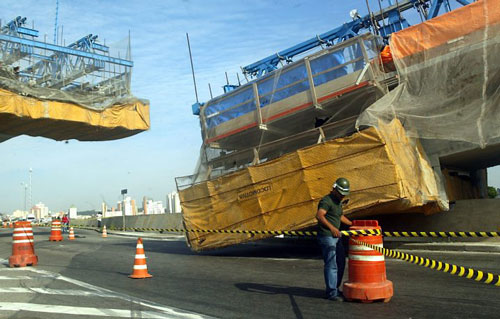

Disse um tempo atrás que estava quase pronto para inaugurar, mas parece que haverá um atraso…
Um trecho desabou em cima do Viaduto Grande São Paulo, parando o trânsito.


 Foi publicado no portal Vitruvius o resultado do concurso para Re-urbanização do campus do Observatório Nacional e Museu de Astronomia, no Rio de Janeiro.
Foi publicado no portal Vitruvius o resultado do concurso para Re-urbanização do campus do Observatório Nacional e Museu de Astronomia, no Rio de Janeiro.
3° lugar – Projeto da arquiteta paisagista Patricia Akinaga, arquiteta Andrea Junqueira Campos e arquiteto Merten Nefs
O projeto de revitalização da “cracolândia”, no centro de São Paulo, está saindo do papel e já está tendo seus primeiros efeitos polêmicos. Ações com 400 policiais da PM e polícia civíl conseguiram expulsar a maioria dos traficantes e usuários do perimetro do projeto. Na ação um número de usuários de crack foi encaminhado para hospitais. Até óntem 24 pessoas foram presas, não foi divulgado se eram traficantes.
A venda e uso das drogas continua nas regiões vizinhas, como República, Santa Cecília e Vila Buarque. Este efeito colateral da operação urbana já havia sido previsto por vários profissionais e organizações no centro da cidade. Mesmo assim, o projeto da prefeitura não incluiu estratégias para resolver esta questão.
Parece que foi comprovada a tese que é possível expulsar o tráfico de drogas de uma região da cidade a força. Certamente, quem tiver um imóvel nas 23 quadras entre as avenidas Rio Branco, Duque de Caxias, Mauá, Cásper Líbero, Praça Alfredo Issa e Avenida Ipiranga, vai se livrar do tráfico, moradores de rua e do IPTU por um bom tempo. Nas regiões vizinhas desse polígono o IPTU sobe e o número de moradores de rua e problemas relacionados ao tráfico crescem. É uma inversão bem interessante. Pelo jeito é ótimo participar da operação, se não, então é melhor ficar longe dela.
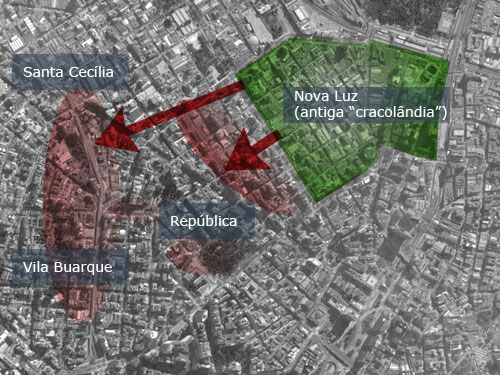
Uma reportagem flagrou na semana passada venda de crack em um novo local, batizado de Nova Cracolândia. Fica na rua dos Gusmões, esquina com a avenida Barão de Limeira. É verdade que a mídia tende a apimentar as notícias, mas os acontecimentos estão ali para todo mundo ver com os próprios olhos. Outras reportagens e observações de moradores dos bairros identificaram situações similares na Vila Buarque e na Avenida São João, entre outros.
Blog do Douglas Nascimento 18-03-2008
www.grandeangular.com/blog/?p=280
Exodus 3.5 – Rumo à Nova Cracolândia (curta metragem)
Globo fantástico 23-03-2008
A nova Cracolândia paulista
http://fantastico.globo.com/Jornalismo/Fantastico/…
Globo SPTV 24-03-2008
Jovens vendem e usam drogas na Nova Cracolândia
Reportagem de Gustavo Minari
http://sptv.globo.com/Sptv/…
Globo Notícias 24-03-2008
Após denúncia, consumo de crack continua no Centro de SP
http://g1.globo.com/Noticias/SaoPaulo/…
A Tarde 25-03-2008
Presos 24 em operação contra tráfico em SP
www.atarde.com.br/brasil/noticia.jsf?id=856927
Apresentação do projeto no site da prefeitura de São Paulo
http://centrosp.prefeitura.sp.gov.br/projetos/novaluz_area.php
Veja também: Nova Luz
Urban Change – Nova Luz São Paulo (2007)
Urban Change – Nova Luz – an update
The link below leads to the Subtopia forum discussion about the aesthetic respresentations of slums / favelas / shantytowns by artists like Dionisio Gonzales, with comments by architect Lebbeus Woods:
http://subtopia.blogspot.com/2007/11/squatter-imaginaries.html
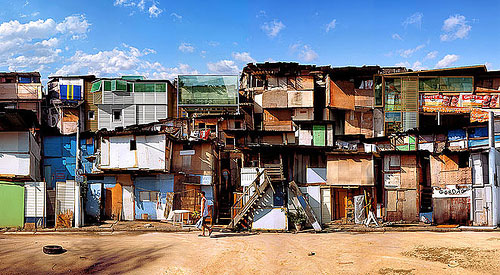
The work of Gonzalez tricks the eye, making the slum look like an abstract composition of materials, and indeed very spacy streets. The question is raised wether Gonzalez has ever been to a favela himself, maybe he just picked the images from the internet and started cutting and pasting? Aestheticizing violence and poverty is concidered controversial, but somehow Western scholars and artists have become intrigued, almost obsessed, by the visuals of the third world slums. Even though these do not occur in the organized first world, or maybe just because of that.

In the third world, slums are normally considered result of social inequality and lack of planning. Some intellectuals of the West however, have regarded the slums of Africa, India and South America as innovative and alternative forms of building the city, a more “pragmatic” and direct one than traditional planning.
Where does the growing attention for slums come from? Are people triggered by the unjustice of slum removals around the globe, described in Mike Davis´ book Planet of Slums, are they disappointed by the results of slum urbanization projects? Or perhaps after a while some of the first worldeners just get bored of the organized, planned and clean aesthetics in which they live and start longing for something more “authentic” and chaotic? Actually, after taking a tourist tour through the Rocinha favela in Rio, one might get the idea that it is very nice and interesting to live in a favela, despite the drug traffic, poverty and lack of infrastructure.
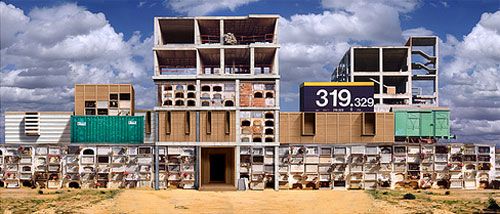
Publications on the subject vary from very objective descriptions of the problem to rather quick judgements from a aesthetic and almost touristic point of view. Rem Koolhaas may have found his truly “generic city” exactly in the shantytowns. Unlike planned urbanization, the un-planned urban poverty looks the same anywhere in world, being the result of true (unvoluntary) minimalism.
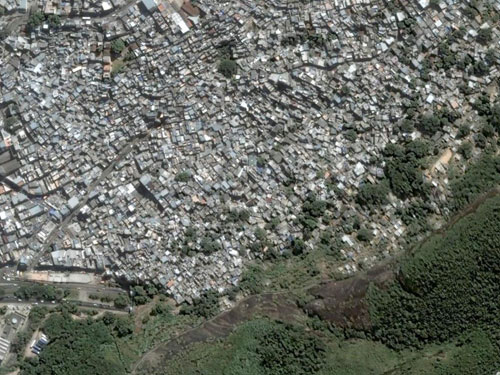
Discussion about the following 3 books on slums:
Mike Davis, Planet of Slums (London, New York: Verso, 2006)
Robert Neuwirth, Shadow Cities: A Billion Squatters, A New Urban World (New York: Routledge, 2006)
Informal City: Caracas Case, Alfredo Brillembourg, Kristin Feireiss, and Hubert Klumpner, eds. (Munich: Prestel, 2005)
www.gsd.harvard.edu/research/publications/hdm/current/27_Beardsley.html
More work of Dionisio Gonzalez
http://fiedler.null2.net/index.php?id=dionisiogonzlez
Forum on favelas (portuguese)
www.arcoweb.com.br/forum/discute.asp?forum_id=28215
“The informal city” at the Rotterdam Architecture Biennale 2007, featuring Caracas, São Paulo and Mexico
www.iabr.nl/page/DVD_Caracas_The_Informal_City
Arif Hasan, The Informal City
UNCHS (Habitat) Regional Symposium on Urban Poverty in Asia
Fukuoka, 27-29 October 1998
www.fukuoka.unhabitat.org/out/siryo/r07.html
Jananese university project on informal settlements
www.informalcity.com
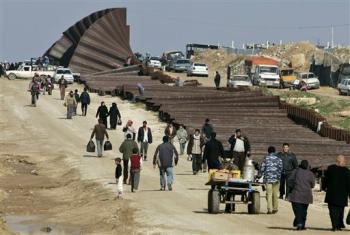
Hungry inhabitants of Gaza invading the nomansland leading to Egypt, where they intend to do some shopping. In the process they leave the Israeli barriers look like a Richard Serra sculpture.
http://subtopia.blogspot.com/2008/01/small-death-in-nomadic-fotress-bossom.html